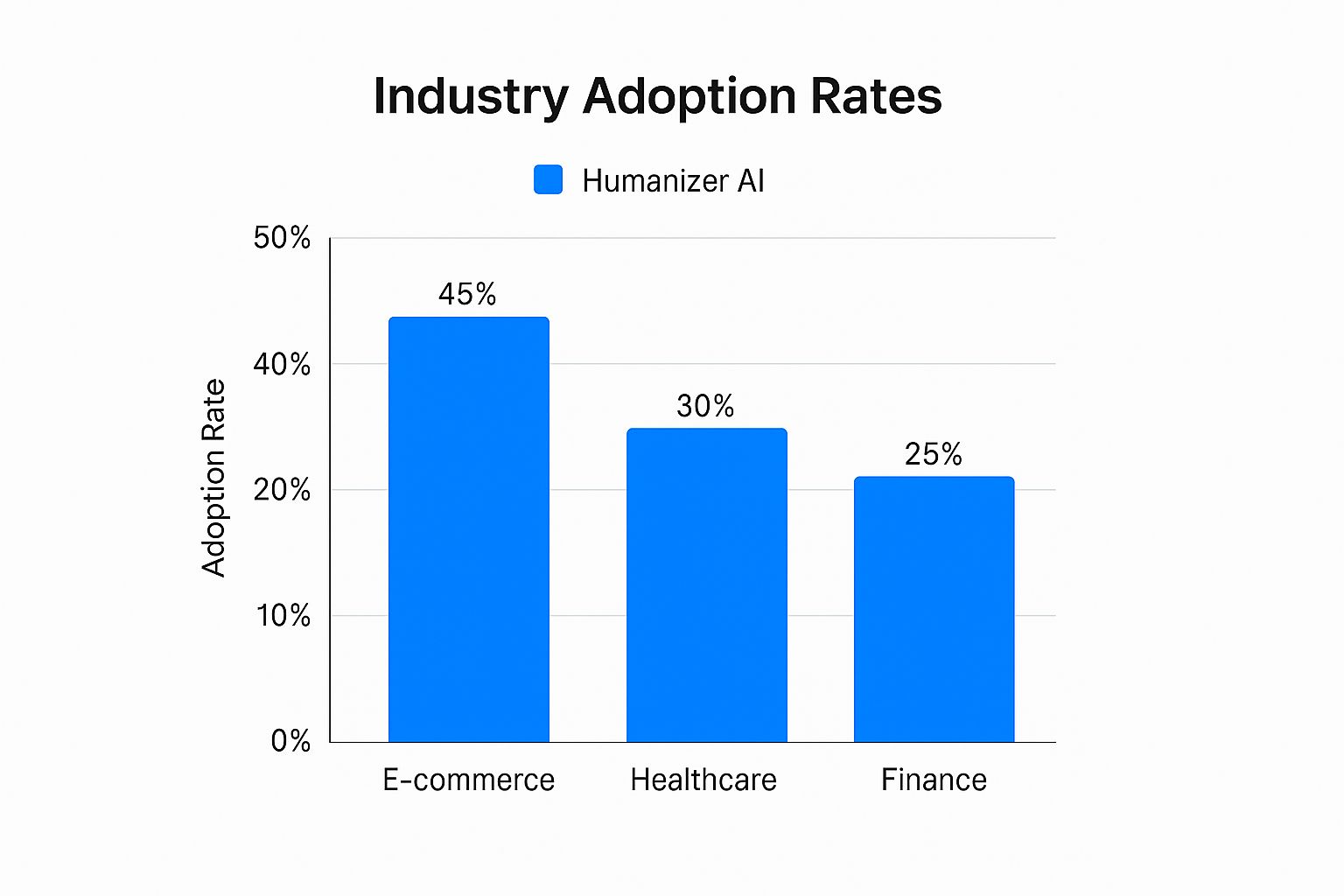What Is a Humanizer AI and How Does It Really Work?

A humanizer AI is a tool that takes text written by an AI and polishes it to sound like it was written by a person. It works by tweaking the tone, sentence structure, and word choices to get rid of that stiff, robotic quality common in raw AI output.
What Does a Humanizer AI Actually Do?
Think of a humanizer AI as a specialty editor for machine-written text. While large language models can churn out content at an incredible speed, the results often feel predictable, a little too formal, or just… off. You might notice the same sentence structures popping up again and again, or words that are technically correct but do not flow naturally.
That is the exact problem these tools are built to fix. To really get why this matters, it is helpful to see its role in refining AI content, especially for anyone trying to improve search rankings by mastering LLM SEO.
A humanizer does more than just swap out a few words. It looks at the text for those tell-tale AI patterns and smooths them out. The whole point is to create content that reads like a human wrote it, which is essential if you want to connect with your audience. If your content sounds like a machine, people are far less likely to trust it or stick around to read it.
The Problem with Raw AI Text
Raw AI content often lacks the subtle touches that make writing feel authentic. For anyone using AI to create content, these shortcomings can be a real roadblock. Some of the most common issues include:
- Repetitive Sentence Patterns: AI often gets stuck in a loop, producing paragraphs where every sentence has the same length or starts the same way. The result is a monotonous, boring read.
- Unnatural Word Choices: Sometimes an AI will use an overly complex or formal word when a simple one would sound much more natural. It just makes the text feel clunky.
- Lack of Cadence and Flow: Human writing has a certain rhythm. AI text can feel choppy and disjointed, making it difficult and unpleasant to read.
- Predictable Phrasing: Because AI models are taught on huge collections of text, they often fall back on generic, uninspired phrases that make the content feel bland.
The Humanizing Solution
A humanizer AI tackles these problems head-on. A quality tool such as Word Spinner, for instance, is built to rewrite text to sound natural while also making sure it is 100% plagiarism-free. Its advanced rewriting abilities help remove AI detection by reworking the writing to introduce variety, making the final piece far more engaging and believable.
The real job of a humanizer AI is not just about tricking a detector—it is about elevating the quality and readability of the content. It’s about turning a functional piece of text into a compelling one that actually connects with people. You can find a deeper dive into specific methods in our guide on how to humanize AI content. Taking this step is crucial for anyone using AI to build trust and achieve better performance.
How AI Humanizers Create a Natural Flow
To get AI text sounding like it was written by a person, an AI humanizer does a lot more than just swap out a few words. Do not think of it as a simple thesaurus. It is more like a skilled editor—or maybe even a musician. Just as a musician adds rhythm and feeling to notes on a page, a humanizer AI breathes life into flat, robotic text.
The whole procedure involves a few clever adjustments that all work together to create a natural, engaging reading experience. It is all about adding the subtle imperfections and variations that you find in actual human communication. The goal is not just to make the text readable, but to make it genuinely relatable.
Varying Sentence Structure and Length
One of the biggest giveaways of AI writing is its predictable rhythm. AI tools often churn out sentences that are all roughly the same length and structure, creating a monotonous drone that can send a reader to sleep. An AI humanizer is built to fight this.
It will break up long, winding sentences into shorter, punchier ones. At the same time, it can combine choppy little phrases into more fluid, complex sentences. This variety is what creates a lively flow and keeps your reader hooked.
- Short Sentences: These create urgency and help key points stand out.
- Medium Sentences: They provide detail and context without overwhelming the reader.
- Long Sentences: These are great for building a more descriptive or thoughtful tone.
By mixing and matching these, the text immediately starts to feel less like a stuffy report and more like a real conversation.
Adjusting Cadence and Word Choice
Beyond just the length of a sentence, the specific words you choose—and how you arrange them—play a massive role in how the text feels. This is its cadence. Human writing is full of idioms, common sayings, and contractions that make it feel personal and real.
A good humanizer AI is taught to see these patterns and weave them into the text. It can swap overly formal words for more common ones and rephrase sentences to sound more conversational. This is the kind of thoughtful adjustment that separates a high-quality humanized text from a basic rewrite.
The core idea is to move away from perfect, sterile grammar and toward the way people actually speak and write. This means introducing contractions like "it's" instead of "it is" or using expressions that add a touch of personality.
It is that final layer of polish that makes your content feel genuine and trustworthy.
Why Human-Sounding Content Is a Business Necessity
Let's be honest, making AI text sound human is not just a stylistic choice anymore. It is a core part of how we communicate in business today. In a digital world overflowing with content, the only way to stand out is to connect with your audience on a personal level.
Content that feels genuine and relatable builds trust, which is the bedrock of any solid customer relationship. When a reader stumbles upon text that is robotic or cold, they check out almost immediately. It puts up a wall and makes your message feel less credible. Using a humanizer AI flips that script, turning flat, machine-written text into something that speaks directly to your audience’s needs.
This simple shift in tone is what builds brand loyalty. It is what encourages people to stick around and actually listen to what you have to say.
Building Trust and Brand Perception
Think of your brand's voice as one of its most critical assets. Every blog post, email, or social media update you publish shapes how people see your company. If that content consistently feels lifeless or manufactured, it can seriously damage your reputation.
Humanized content, on the other hand, breathes personality and care into your brand. It is a clear signal to your audience that there is a real person on the other side of the screen who gets them. That authenticity is exactly what you need to build a positive brand image and earn the confidence of potential customers.
The more your content connects on a human level, the more likely people are to trust your expertise and choose you over the competition. It is that simple.
Boosting SEO and Reader Engagement
Search engines have gotten a lot smarter over the years. They are no longer just scanning for keywords; they are giving preference to content that people actually enjoy reading. That means authentic, natural-sounding language is a huge factor in modern SEO.
Stiff, repetitive AI text often leads to high bounce rates, which tells search engines that your content is not hitting the mark. The numbers tell a compelling story here. Studies have shown that humanized content can pull in 45.41% more impressions and get a staggering 60% more clicks.
This kind of improvement has a direct impact on your search performance, making a humanizer AI a crucial tool for boosting both visibility and reader interest.
A human-like tone keeps readers on the page longer, encourages them to explore more of your site, and makes them more likely to share your content. All of these are positive signals that can improve your rankings over time.
This focus on quality is a growing concern for creators who want to steer clear of AI checking systems. By improving AI-written drafts to sound genuinely human, you not only improve the reader's experience but also reduce the risk of your content being flagged. You can discover more on this subject in our related article on why humanizing AI content is essential for engagement.
In the end, turning AI output into human-sounding text is not just about avoiding penalties; it is about creating content that truly performs.
Practical Ways to Use Humanizer AI Tools
Theory is great, but the real magic of a humanizer AI happens when you put it to work. These tools are quickly becoming a go-to for professionals in all sorts of fields, closing the gap between the raw efficiency of AI and the genuine human touch needed to actually connect with people. Think of it as the final polish that turns a sterile, machine-written draft into something compelling and relatable.
Marketers use them to write ad copy that converts, and bloggers use them to make their posts feel more personal and authentic. Even students are getting in on the action, using humanizers to improve AI-assisted essays so they sound less like a robot and more like their own voice.
Improving Marketing and Sales Copy
In marketing, every word is an opportunity. Your goal is to build a connection and gently nudge the reader toward taking action. A humanizer AI is brilliant for improving ad copy, email campaigns, and landing pages to sound more persuasive and less like a generic sales pitch from a faceless corporation.
By smoothing out clunky phrases and adding a more conversational tone, it helps you craft messages that actually resonate with your audience on an emotional level. It is a small tweak that can have a huge impact on your conversion rates.
Enhancing Content Creation and SEO
For bloggers, journalists, and SEO pros, the pressure to produce a steady stream of high-quality content is relentless. A humanizer AI can be a big help here in a few key ways:
- Boosts Readability: It breaks up those long, monotonous sentences, making your articles much easier and more enjoyable to read.
- Strengthens Brand Voice: It makes sure that every piece of content—even if it started as an AI draft—is perfectly in line with your brand personality.
- Avoids AI Detection: It reworks the text to sound completely natural, which helps you sidestep the dreaded AI content checkers.
We dive deeper into this procedure in our guide on how to use AI humanizer tools to make your writing sound natural.
The image below shows just how quickly different industries are adopting humanizer AI, highlighting their growing importance in the modern workplace.
As you can see, e-commerce is leading the pack, which makes total sense given the need for human-like communication in customer service and sales. This trend is not slowing down, either. The AI agent market is projected to explode to $47.1 billion by 2030. With experts predicting that 80% of customer interactions will soon be handled by AI, humanizers are becoming absolutely essential for making those conversations feel genuine and empathetic.
Aiding Academic and Professional Writing
Students and academics often turn to AI to help organize their thoughts and structure complex papers. A humanizer AI adds that crucial final layer of polish, improving drafts to meet the high standards of academic writing. It helps make sure the final paper is clear, coherent, and carries an authoritative tone.
In a business context, these tools are fantastic for cleaning up reports, presentations, and even internal emails. They make sure all your business documents are professional, easy to understand, and free from awkward, machine-written language.
And it is not just about improving text. The use of AI is expanding into other areas of content creation, too. For instance, some tools can now create interactive learning materials like AI-generated video quizzes. This just goes to show how adaptable these technologies have become across all sorts of professional and educational fields.
Humanizer AI Use Cases by Profession
Different jobs have different needs, but the goal is often the same: clear, effective communication. The table below breaks down how various professionals are using humanizer AI tools to step up their game.
| Profession | Primary Use Case | Desired Outcome |
|---|---|---|
| Marketer | Improving ad copy and email campaigns | Higher engagement and conversion rates |
| Blogger | Enhancing readability and brand voice | More authentic connection with readers |
| SEO Specialist | Creating unique, high-quality content | Improved search rankings and user experience |
| Student | Polishing essays and research papers | Clearer arguments and a stronger academic voice |
| Business Pro | Drafting reports and client emails | Professional, persuasive communication |
| Customer Support | Humanizing automated responses | Increased customer satisfaction and trust |
As you can see, the applications are incredibly broad. No matter the industry, humanizer AI is helping people communicate more effectively and build stronger connections with their audience.
How to Choose the Right AI Humanizer
With a flood of new tools hitting the market, picking the right humanizer AI can feel overwhelming. The secret is to look past the flashy marketing and zero in on what actually helps you get your work done. A good tool should feel less like software and more like a reliable partner, one that consistently provides natural-sounding text without giving you a headache.
The very first test is simple: check the output quality. Before you commit to anything, run a few sample pieces of text through the tool. Does the result actually sound like something a person wrote, or is it just a jumbled mess of synonyms that misses the point? You need a tool that truly understands the context and nuance of your original text, not one that just plays word swap.
Key Factors to Consider
As you start comparing different humanizers, a few key factors will help you separate the genuinely useful tools from the duds. It really comes down to finding the right balance of performance, user-friendliness, and the specific functions your projects demand. Keeping these points in mind will steer you toward a tool you can count on.
Here is what you should be looking for:
- Output Quality and Natural Tone: This is the big one. The rewritten text absolutely must flow smoothly and have a believable, human rhythm. No exceptions.
- Ability to Avoid AI Detectors: A top-tier humanizer should produce content that consistently passes as human-written when run through checking software.
- Ease of Use: You should not need to read a technical manual just to figure it out. The best tools have a clean, straightforward interface that lets you get in, get your content, and get out.
- Customization Options: The ability to tweak the writing style or tone is a major benefit. This control makes sure the final output perfectly matches your brand’s voice or the specific needs of a project.
Making the Right Choice for Your Needs
The global artificial intelligence market is already valued at around $391 billion, and it's on track to grow fivefold in the next few years. That's a massive expansion, and it means more businesses are relying on AI than ever before—in fact, 83% of companies now consider it a top priority. For anyone creating content, this trend makes choosing a solid humanizer AI absolutely critical.
When you are ready to make a choice, consider a proven option like Word Spinner. It’s designed to humanize content for a natural tone and guarantees 100% original, plagiarism-free output. That makes it a dependable tool for serious creators who need results they can trust.
At the end of the day, the best humanizer AI is the one that fits right into your workflow and helps you create better content, faster. Do not settle for a tool that spits out awkward, robotic text. Take the time to find one that genuinely understands the art of human language.
For a deeper dive into what makes a great tool, check out our ultimate guide to choosing the best AI humanizer software. It offers a detailed comparison to help you make a fully informed decision.
Common Questions About Humanizer AI
As we wrap up, it is natural to have a few questions swirling around. Let's tackle some of the most common ones that pop up when people start looking into humanizer AI. This is your quick, no-nonsense guide to clear up any lingering doubts.
Think of this as the final piece of the puzzle, designed to give you the confidence to use these tools effectively.
Will A Humanizer AI Get Past All AI Detectors?
A good humanizer AI dramatically boosts your chances of flying under the radar, but no tool can promise a 100% pass rate every single time. Why? Because the technology on both sides—humanizers and detectors—is in a constant state of flux.
The best humanizers work by fundamentally restructuring content to mirror human writing patterns. They vary sentence structures, inject natural-sounding language, and create a logical flow that feels authentic. The goal is not just to trick a machine but to produce content that is genuinely difficult to distinguish from something a person wrote. That is your best defense.
Is Using A Humanizer AI A Form of Plagiarism?
Not at all. Think of a humanizer AI as a highly advanced editing assistant. You are providing the initial text, and the tool is simply rephrasing and restructuring it. If you are running your own AI-written draft through it, you are just improving your work.
The best tools also come with plagiarism checkers to make sure the final output is completely original and does not accidentally mirror existing content online. The key is to always start with your own ideas or properly sourced material. As long as your foundation is ethical, you are in the clear.
This lets you maintain total academic and professional integrity while getting the benefit of polished, natural-sounding text.
Can I Use A Humanizer For School Or University Work?
Yes, a humanizer AI can be a huge help with academic writing. It is great for polishing drafts to sound more professional and meet the high standards expected in essays and research papers. It can really shine when it comes to improving sentence flow and making your arguments clearer and more persuasive.
However—and this is critical—you absolutely must check and follow your institution's specific guidelines on using AI tools. Use a humanizer to improve your own work and refine your own ideas, not to create text that you pass off as your own without putting in the genuine effort.
Does It Take A Long Time To Humanize AI Content?
Not even close. In fact, speed is one of the biggest perks of using a humanizer AI. The whole procedure is incredibly fast.
You just copy and paste your text into the tool, and it gives you a humanized version in a matter of seconds. For longer documents, it might take a minute or two. This is worlds faster than trying to manually rewrite a long article, letting you produce high-quality, natural-sounding content in a fraction of the time.
Ready to turn your AI-written text into content that truly connects with your audience? Word Spinner offers advanced rewriting that adds a natural, human touch, ensures your text is 100% plagiarism-free, and helps it sail past AI detectors. Try it today and see the difference for yourself at https://word-spinner.com.



